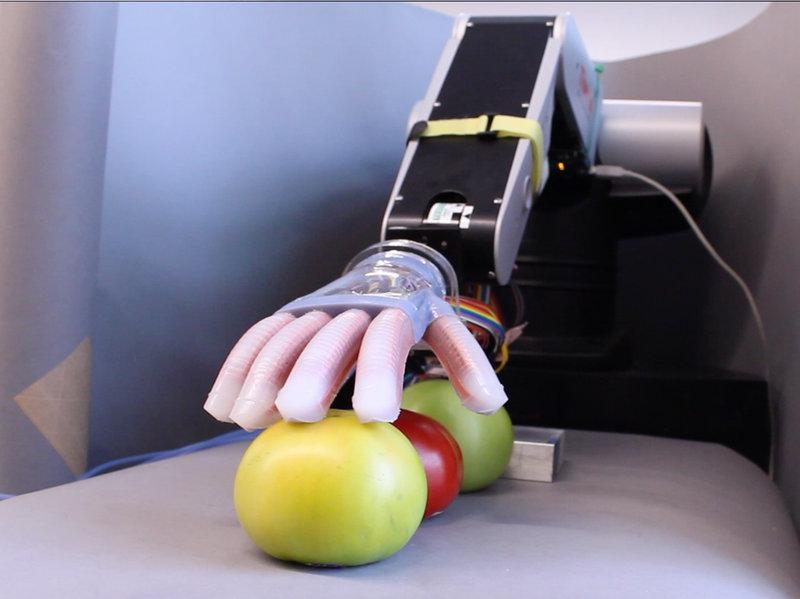 What’s so incredible about the soft robotic hand created by a team at Cornell? It can grip, sort, and sense what it is touching. But what’s truly astounding is the potential it offers in terms of price and prosthetics for the future. Bringing forth further innovation and progress to the world of robotics, at $50 one can see how it might have realistic, significant impact on numerous levels.
What’s so incredible about the soft robotic hand created by a team at Cornell? It can grip, sort, and sense what it is touching. But what’s truly astounding is the potential it offers in terms of price and prosthetics for the future. Bringing forth further innovation and progress to the world of robotics, at $50 one can see how it might have realistic, significant impact on numerous levels.
Dispelling the idea of robots as lovable but clunky machines with a steel and rigid grip, Cornell researchers have managed to create what looks like—and offers the feel of—a human hand. This means that the task list for robots may expand exponentially as they are able to handle more delicate items, to include items like food and other fragile products. This also means that they would be able to work with people without injuring them, such as in a medical setting.
The secret to these soft robotics is in the materials and the manufacturing, an area seeing expanded study and use recently for a variety of applications. Going beyond the conventional robotic components which most of us visualize as metal and moving in a slow, methodical way, the research team began experimenting with more fluid actuators and sensors. They have outlined their findings in ‘Optoelectronically innervated soft prosthetic hand via stretchable optical waveguides,’ authored by Huichan Zhao, Kevin O’Brien, Shuo Li, and Robert F. Shepherd. Published in this month’s Science Robotics, the paper explains how the prosthetic hand was created via 3D printing, soft lithography, and soft robotics.“We believe that the easy fabrication, low cost, chemical compatibility, and high repeatability of the developed stretchable waveguide sensors will benefit the field of robotics (e.g., soft robot bodies and skins for hard ones),” states the team in their paper. “In addition, we demonstrated that soft prosthetic hands could not only perform dexterous manipulation but also achieve various haptic sensing functions through simple innervation and control.”
The team used an Objet 3D printer in creating molds for the cladding, which is the covering of the robotic hand. They then used LEDs for the source of light, along with a photodetector that functions as the light sensor for the waveguides.
Huichan Zhao is a doctoral candidate in mechanical engineering at Cornell and the lead author of the paper. She points out that these particular robots must be able to conduct light as they are sensor driven.
“Our human hand is not functioning using motors to drive each of the joints; our human hand is soft with a lot of sensors … on the surface and inside the hand,” she says. “Soft robotics provides a chance to make a soft hand that is more close to a human hand.”
The robot is guided by the light sensors which run through the waveguides composed of fabricated pipes. The hand responds, waveguides move, and the robot receives corresponding data as it comes into contact with objects. The project is obviously a start for furthering robotics, but there are still challenges to overcome as well from the question of ongoing energy sources required for movement to the use of other materials.
Robert Shepherd is an assistant professor of mechanical and aerospace engineering at Cornell, and he sees what they have created as the future of more affordable and sophisticated prosthetic hands. Not only can they be made more easily and cheaply, but they offer the users so much more, including an actual sense of touch because of the soft material. With mass production, Zhao sees the soft robotic prosthetics being made for even less than $50.
And as for the sense of touch, the research team has not yet been able to connect that to brain waves but Shepherd and the rest of the group are currently looking for partners as they work to test it on humans. Discuss in the Soft Robotics forum at 3DPB.com.
[Source: NPR]
Subscribe to Our Email Newsletter
Stay up-to-date on all the latest news from the 3D printing industry and receive information and offers from third party vendors.
Print Services
Upload your 3D Models and get them printed quickly and efficiently.
You May Also Like
Reinventing Reindustrialization: Why NAVWAR Project Manager Spencer Koroly Invented a Made-in-America 3D Printer
It has become virtually impossible to regularly follow additive manufacturing (AM) industry news and not stumble across the term “defense industrial base” (DIB), a concept encompassing all the many diverse...
Inside The Barnes Global Advisors’ Vision for a Stronger AM Ecosystem
As additive manufacturing (AM) continues to revolutionize the industrial landscape, Pittsburgh-based consultancy The Barnes Global Advisors (TBGA) is helping shape what that future looks like. As the largest independent AM...
Ruggedized: How USMC Innovation Officer Matt Pine Navigates 3D Printing in the Military
Disclaimer: Matt Pine’s views are not the views of the Department of Defense nor the U.S. Marine Corps Throughout this decade thus far, the military’s adoption of additive manufacturing (AM)...
U.S. Congress Calls Out 3D Printing in Proposal for Commercial Reserve Manufacturing Network
Last week, the U.S. House of Representatives’ Appropriations Committee moved the FY 2026 defense bill forward to the House floor. Included in the legislation is a $131 million proposal for...



































